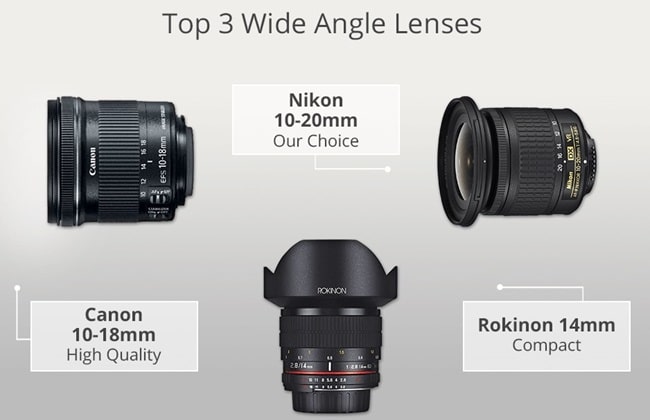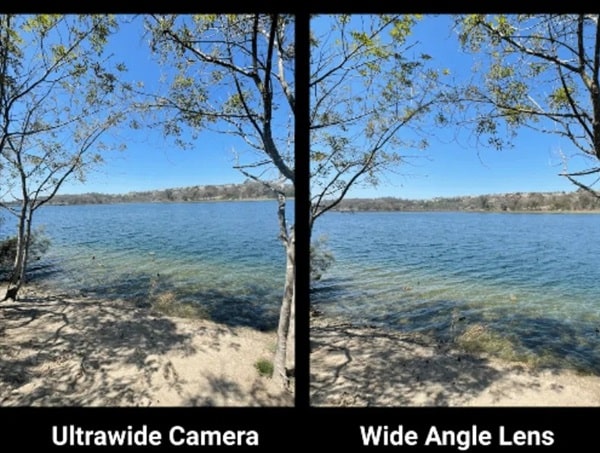A landscape photographer’s canvas is wide and includes amazing views, tranquil settings, and astounding natural treasures. A wide-angle lens is an essential tool for capturing these expansive views in their entirety.
Photographers who want to convey to their audience the immensity of the natural world love it for its capacity to capture a greater field of view and highlight the majesty of the surroundings. But choosing the ideal wide-angle lens may be difficult given the abundance of alternatives available.
This thorough book explores the nuances of wide-angle lenses, giving both novices and experts the information they need to make wise choices and realize the best possible landscape photography.
The Fundamentals of Broad-Angle Lenses
The lower focal lengths of wide-angle lenses, which usually range from 10mm to 35mm, define them. They may capture a wider field of view than ordinary lenses because of their shorter focal length, which produces photographs that show more of the scene.
Straight lines near the frame’s boundaries are distorted by the broader perspective, giving the image a feeling of depth and expansiveness that is especially appealing for landscape photography.
Wide-Angle Lenses’ Benefits for Landscape Photography
For a number of reasons, wide-angle lenses work well in landscape photography. They make it possible for photographers to portray the immensity and majesty of the natural world via expansive panoramas.
Their capacity to fit more objects inside the frame gives the scene a wider context, which improves the image’s narrative potential. Although perspective distortion is often seen as a drawback in portraiture, it may be used to emphasize the size and grandeur of a location in landscape photography by producing dramatic effects.
Different Wide-Angle Lens Types

There are many varieties of wide-angle lenses, each having special qualities and uses. Prime lenses provide outstanding clarity and low light performance. They are known for their quicker aperture and higher picture quality.
Their usefulness is nonetheless limited by their fixed focal length. Zoom lenses, however, provide photographers greater versatility by allowing them to change the field of view without moving. Their portability is sacrificed for speed and picture quality, which may not be as good as prime lenses.
Selecting Proper Focal Length
The intended topic and desired viewpoint are important considerations when choosing the ideal focal length for landscape photography. With focal lengths ranging from 10 to 20 mm, ultra-wide-angle lenses are perfect for photographing expansive vistas, architectural details, and striking viewpoints.
With focal lengths ranging from 24 to 35 mm, wide-angle lenses provide a well-balanced view that captures a respectable portion of the subject while retaining some perspective.
Comprehending Depth of Field and Aperture
Wide-angle photography heavily relies on aperture, the lens’s opening that regulates how much light enters the camera. A narrower depth of field is made possible by a larger aperture (lower f-number), which focuses on the foreground while blurring the background to isolate and highlight the subject.
For photographing landscapes with a lot of depth, a smaller aperture (higher f-number) optimizes depth of field and ensures perfect focus from foreground to background.
The Significance of Lens Warping
Even though lens distortion is often seen as a bad thing, it may be artistically controlled in landscape photography. Exaggerating straight lines close to the frame’s edge may give the picture a feeling of excitement and vitality, giving it a distinctive viewpoint and directing the viewer’s attention to certain focal spots.
Excessive distortion, however, may be harmful and lead to uncomfortable exaggerations. Making wise selections and attaining the intended visual impact need an understanding of a lens’ distortion properties.
The Function of Filters in Broad-Angle Shots
In order to improve landscape photography, filters are essential, especially when using wide-angle lenses. Polarizing filters improve colors and contrast by reducing glare and reflections, particularly in scenes with water, sky, and vegetation.
By lowering the quantity of light entering the camera, neutral density (ND) filters allow photographers to utilize slower shutter speeds to capture motion blur or produce ethereal effects in brightly lit settings.
With the use of graduated ND filters, photographers may get a more balanced and realistic-looking picture by adjusting the exposure between brilliant sky and darker foregrounds.
Advantages and Disadvantages of Wide-Angle Lenses
Broad Field of View
The capacity of wide-angle lenses to capture a broader field of view than conventional lenses is one of its most important features. Photographers are able to capture a larger area of the picture with this wide angle, showcasing the majesty of the surrounds and drawing viewers into the immensity of the natural world.
A larger context is provided by being able to include more things in the frame, which improves the image’s narrative potential. This function is very useful for taking pictures of panoramic landscapes, since the expansive views need a broad viewpoint.
Improved Perspective and Depth
It is difficult to get a feeling of depth and perspective with regular lenses; wide-angle lenses do this. In landscape photography, the distortion effect—which is often seen as a disadvantage in other genres—becomes a creative asset.
Exaggerating straight lines close to the frame’s edge may give the picture a feeling of excitement and vitality, giving it a distinctive viewpoint and directing the viewer’s attention to certain focal spots.
Viewers are given the impression that they are standing within the photograph because to the exaggerated perspective, which highlights the scene’s majesty and magnitude.
Flexibility in Formulation
With the compositional versatility that wide-angle lenses provide, photographers may try out various angles and setups. By using foreground objects that draw the viewer’s attention to the primary subject and give the picture depth and interest, they may be utilized to create visually arresting compositions.
The picture’s visual attractiveness is increased by the ability to include background, middle ground, and foreground objects in the frame to create a dynamic and well-balanced composition.
Drawbacks:
Warp
Using wide-angle lenses naturally results in lens distortion, especially around the borders of the frame. Exaggerated straight lines give the impression of being bent or bowed.
Even while this distortion may be artistically used to emphasize perspective, there are times when it can be problematic, especially when taking pictures of architectural objects or situations where straight lines are crucial. Careful composition and post-processing methods can reduce distortion.
Depth of Field Factors
Since wide-angle lenses sometimes have a deeper depth of field than normal lenses, more of the image will be sharply focused. This is useful for landscape photography, since it’s typically desirable to have the whole picture in crisp focus.
To achieve selective focus, nevertheless, might present some difficulties since it can be hard to separate the topic from the backdrop. In order to get around this restriction, photographers often use methods like using a bigger aperture or carefully arranging objects in the background and foreground to get the appropriate depth of focus.
Issues with Image Quality
Although wide-angle lenses may provide sharp pictures, there could be some trade-offs. Because of their very long focal lengths, ultra-wide-angle lenses may cause vignetting, which is the effect of the image’s corners seeming darker than the center.
Furthermore, particularly at the margins, wide-angle lenses may find it difficult to maintain constant sharpness across the frame. Minimizing these problems may be achieved by shutting down the aperture and using a lens with excellent optical quality.
Selecting the Ideal Broad-Angle Lens
Focal Length: Ultra-Wide vs Wide

The subject matter and intended viewpoint determine whether wide-angle or ultra-wide-angle lens is best. With focal lengths ranging from 10 to 20 mm, ultra-wide-angle lenses are perfect for photographing expansive vistas, architectural details, and striking viewpoints.
They may be used to highlight the scene’s size and grandeur while fostering a feeling of immersion. They may, however, also result in noticeable distortion, especially around the frame’s corners.
With focal lengths ranging from 24 to 35 mm, wide-angle lenses provide a well-balanced view that captures a respectable portion of the subject while retaining some perspective. Since they provide a less distorted, more natural-looking viewpoint, they are often used for general landscape photography.
In addition, wide-angle lenses work well for street and architectural photography, among other types of photography.
Zoom vs. Prime Lenses
Prime lenses provide outstanding clarity and low light performance. They are known for their quicker aperture and higher picture quality. For photographers who value clarity and sharpness in their images, they are perfect. Their usefulness is nonetheless limited by their fixed focal length.
Zoom lenses, however, provide photographers greater versatility by allowing them to change the field of view without moving. Their portability is sacrificed for speed and picture quality, which may not be as good as prime lenses.
Things to Take Into Account
The choice of a wide-angle lens is influenced by a number of other parameters in addition to focal length and lens type. Important factors to take into account include image quality, aperture, size and weight, focusing capabilities, and cost.
The perfect lens will have a feature set that strikes a balance between the photographer’s demands and budget.
Common Wide-Angle Lens Types

Many different manufacturers provide a large selection of wide-angle lenses on the market. Canon EF 16-35mm f/4L IS USM, Nikon AF-S NIKKOR 14-24mm f/2.8G ED, Sony FE 16-35mm f/2.8 GM, and Sigma 14-24mm f/2.8 DG DN Art are a few of the well-liked options.
These lenses are very well-liked for their performance, adaptability, and picture quality.
Popular Wide-Angle Lens Table
| Lens | focal length | Opening | Sort | Producer |
|---|---|---|---|---|
| EF 16-35mm f/4L IS USM from Canon | 16–35 mm | f/4 | Enlarge | Canon |
| Nikon 14–24mm f/2.8G ED AF-S NIKKOR lens | 14–24 mm | f/2.8 | Enlarge | Nikon |
| FE 16-35mm f/2.8 Sony GM | 16–35 mm | f/2.8 | Enlarge | Sony |
| DG DN Art, Sigma 14-24mm f/2.8 | 14–24 mm | f/2.8 | Enlarge | Sigma |
| VC USD G2 Tamron SP 15-30mm f/2.8 Di | 15–30 mm | f/2.8 | Enlarge | Tamron |
| Opera 16-28mm f/2.8 FF Tokina | 16–28 mm | f/2.8 | Enlarge | Tokina |
| Zero-D Laowa 12mm f/2.8 | 12 mm | f/2.8 | first-rate | Venus Optics |
In summary
Developing Your Capabilities in Landscape Photography
Selecting the ideal wide-angle lens is essential to maximizing the quality of your landscape photos. You may capture expansive views, portray the majesty of the natural world, and produce photographs that engross people in the beauty of your surroundings when you have a wide-angle lens in your toolbox.
Creative expression and the production of visually arresting compositions are made possible by the control over perspective and distortion. By being aware of the advantages and disadvantages of wide-angle lenses, you may use them to your advantage and take stunning landscape photos.
Try New Things and Find Your Style
Don’t be scared to explore the possibilities of various wide-angle lenses by experimenting with them. To find the compositions, viewpoints, and focal lengths that best suit your subject matter and style, experiment.
The creative process includes the quest for the ideal lens, and experimenting will provide fresh findings and understandings.
Accept the Mistake
Even though it’s often seen negatively, lens distortion may be an effective technique for sharpening perspective and producing striking effects. Accept the exaggeration of straight lines and work with them to create compositions that are distinctive.
Make the most of distortion to highlight the scope and majesty of your topic.
Learn the Methods
For best results, wide-angle photography necessitates certain procedures. Gain mastery over perspective, reduce distortion, and regulate depth of field.
Learn how to use filters to adjust exposure, contrast, and color, and experiment with post-processing methods to make your photos seem better.
Pay Attention to Composition
In landscape photography, composition is key, and wide-angle lenses provide plenty of room for artistic arrangement. Focus on the objects in the front, center ground, and background. Use leading lines to direct the viewer’s attention. Play around with various viewpoints and angles to create compositions that are captivating and exciting.
Accept the Creative Process
Exploration, artistic expression, and discovery are all part of the adventure that is landscape photography. Don’t be scared to go outside of your comfort zone and try out new lenses, methods, and strategies.
You will be motivated to keep improving as a photographer by the fulfilling experience of attempting to capture the beauty of the natural world.
Put Money Into Quality
Although there are wide-angle lenses that are affordable, buying a high-quality lens may have a big influence on your entire photography experience and the quality of your images
With the greater sharpness, low light performance, and longevity that a good lens offers, you may shoot stunning vistas in crystal clear, detailed detail.
Conclusion
With the use of wide-angle lenses, landscape photographers may capture the majesty of the natural world with greater ease. You can bring the scope of the scene to life, provide striking views, and enthrall viewers with the beauty of your surroundings when you have a wide-angle lens in your toolbox.
By being aware of the advantages and disadvantages of wide-angle lenses, you may use them to your advantage and take stunning landscape photos. To take your landscape photography to the next level, don’t forget to explore, accept distortion, learn the skills, concentrate on composition, and make quality investments.
This manual is meant to be used as a beginning point, offering a basis for your investigation into wide-angle lenses. Finding the ideal lens is a personal process that is impacted by your requirements, preferences, and financial situation.
As you pursue your photography endeavors, never forget to try new things, pick up new skills, and develop—always looking for fresh approaches to capturing the beauty of the natural world.

